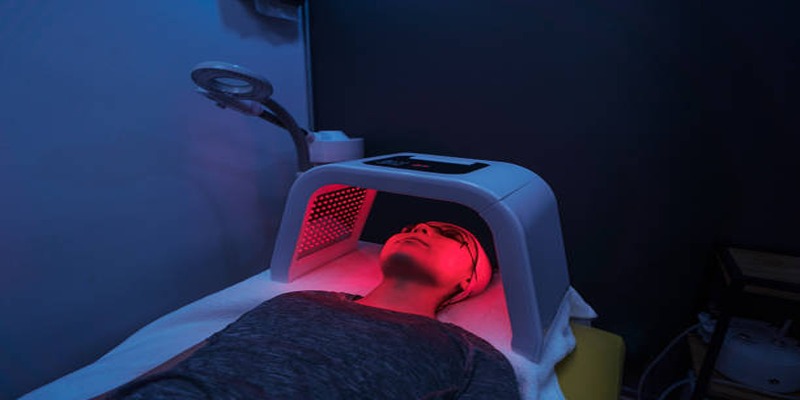Light therapy is gaining attention as a new and promising way to treat acne, a common skin condition affecting many people. It involves using specific wavelengths of light to target and reduce acne-causing bacteria and inflammation on the skin. This non-invasive treatment is appealing because it might come with fewer side effects compared to traditional methods like creams or oral medications. People are increasingly looking for effective and safe solutions for their skin problems, and light therapy could be a game-changer. In this guide, we will explore how light therapy works and its potential benefits for acne sufferers.
What is Acne?
Acne is a skin condition caused by the blocking of skin pores by oils and secretions, dead cells and bacteria. This results in inflammation which leads to the formation of pimple, black head or white head formation. Acne results from hormonal imbalance, heredity, diet, stress, and specific drugs.
There is a popular belief that people get acne only when they are in high school, that is not true. About 85 percent of young people, aged 12-24 years, are affected by acne at some point. In most cases acne has adverse effects on the self-esteem of many users, and this reduces the quality of life. So, the search for effective treatments is relevant.
Light Therapy for Acne

Light therapy or phototherapy or LED therapy is type of treatment that involves the delivery of light in various forms through the skin tissue to reach out to the targeted cells in the human body. Red light and blue light are implemented for acne treatment.
Red Light Therapy
Recent studies have revealed that red light has an effective solution in reducing inflammation and in enhancing circulation. It also promotes collagen formation as an outcome of which there is an enhancement of the quality of the skin. With regards to acne, reddish light affects sebaceous glands in the skin to decrease oil and eliminate bacteria on the skin surface.
Blue Light Therapy
Blue light has antibacterial properties and can effectively kill acne-causing bacteria called Propionibacterium acnes. It also helps regulate oil production and can reduce the appearance of acne scars.
Types of Light Therapy Devices for Acne
- LED Masks: LED masks are a popular at-home option for light therapy treatment. They are designed to cover the entire face and emit both red and blue light.
- Handheld devices: These are portable devices that can be used at home or on-the-go. They come in different sizes, with varying numbers of LEDs and wavelengths.
- Professional devices: Dermatologists may use more powerful professional devices in-office, which can provide faster results but require multiple sessions.
Benefits of Light Therapy for Acne
- Non-Invasive: Unlike other acne treatments like medications or chemical peels that can cause discomfort or irritation, light therapy is non-invasive and pain-free. This makes it a more appealing option for those with sensitive skin.
- Customizable Treatment: Every person's skin is unique, and so are their acne problems. With light therapy, the wavelength and intensity of the light can be adjusted to suit individual needs.
- Convenient: Light therapy sessions are typically short (around 15-30 minutes) and can be done at home with a personal LED device or in a professional setting like a dermatologist's office. This makes it a convenient option for those with busy schedules.
- Long-Lasting Results: While some acne treatments may provide temporary relief, light therapy has been shown to have long-lasting effects and can prevent future breakouts when used consistently.
Comparison with traditional acne treatments
While traditional acne treatments like topical creams or oral medications can be effective for some people, they often come with side effects and may not work for everyone. Light therapy offers a safe and customizable alternative that can provide similar results without the potential risks.
Things to Consider before Trying Light Therapy
Before starting light therapy for acne, here are a few things to keep in mind:
- Talk to your dermatologist: It's important to consult with a dermatologist before trying any new acne treatment. They can assess your skin and determine if light therapy is suitable for you.
- Consistency is key: Like any other skincare routine, consistency is crucial for seeing results with light therapy. Make sure to follow the recommended treatment plan and use the device regularly for optimal results.
- Patience is necessary: Light therapy is not a quick fix for acne. It may take several weeks or even months to see significant improvements in your skin's appearance. Be patient and give the treatment time to work.
Potential Side Effects and Risks of Light Therapy

While light therapy is generally considered safe, there are a few potential side effects and risks to be aware of:
- Eye damage: Staring directly at the light source can cause eye damage, so it's important to always wear protective goggles during treatment.
- Temporary skin irritation: Some people may experience temporary redness, dryness, or peeling after treatment. This usually subsides within a few days.
- Allergic reactions: In rare cases, some individuals may have an allergic reaction to the light or materials used in the device.
If you experience any concerning side effects during or after treatment, stop immediately and consult with your dermatologist.
Who Can Benefit from Light Therapy?
Light therapy can benefit individuals of all ages and skin types, but it may be particularly effective for those with mild to moderate acne. It is also a great option for people who are looking for a natural and non-invasive treatment method.
Conclusion
Light therapy is an effective and convenient treatment option for acne sufferers. It offers numerous benefits such as being non-invasive, customizable, and providing long-lasting results. However, it's important to consult with a dermatologist before trying light therapy and to use the device consistently for optimal results. With patience and proper care, light therapy can help improve the appearance of acne-prone skin and boost self-confidence. So if you're struggling with acne, consider giving light therapy a try and see the results for yourself. Remember, beautiful skin is achievable with the right treatment and care.











